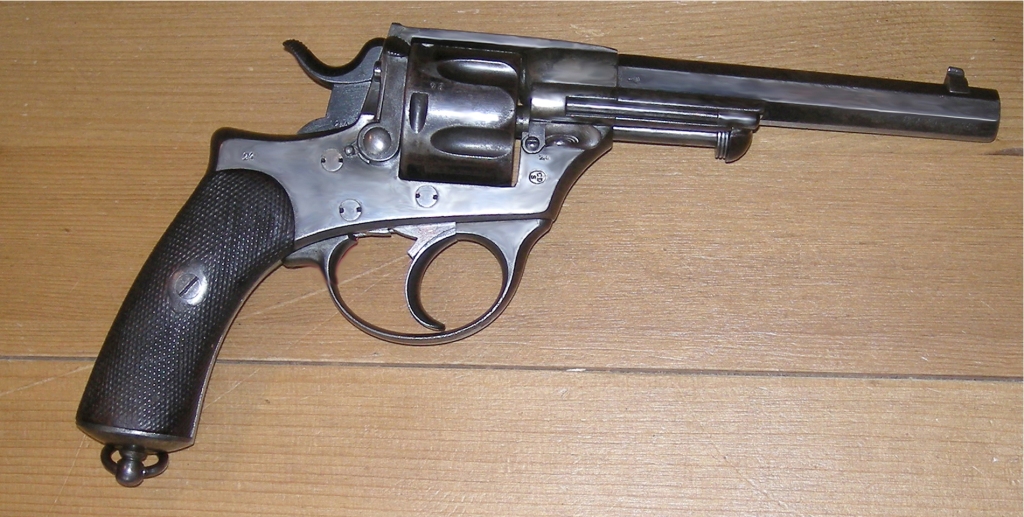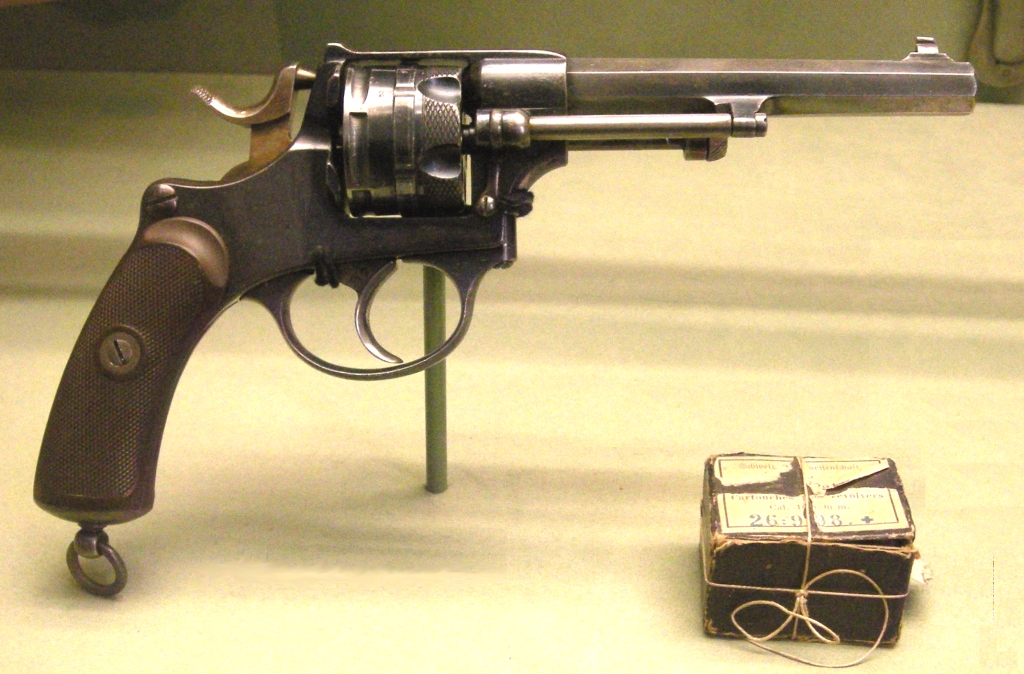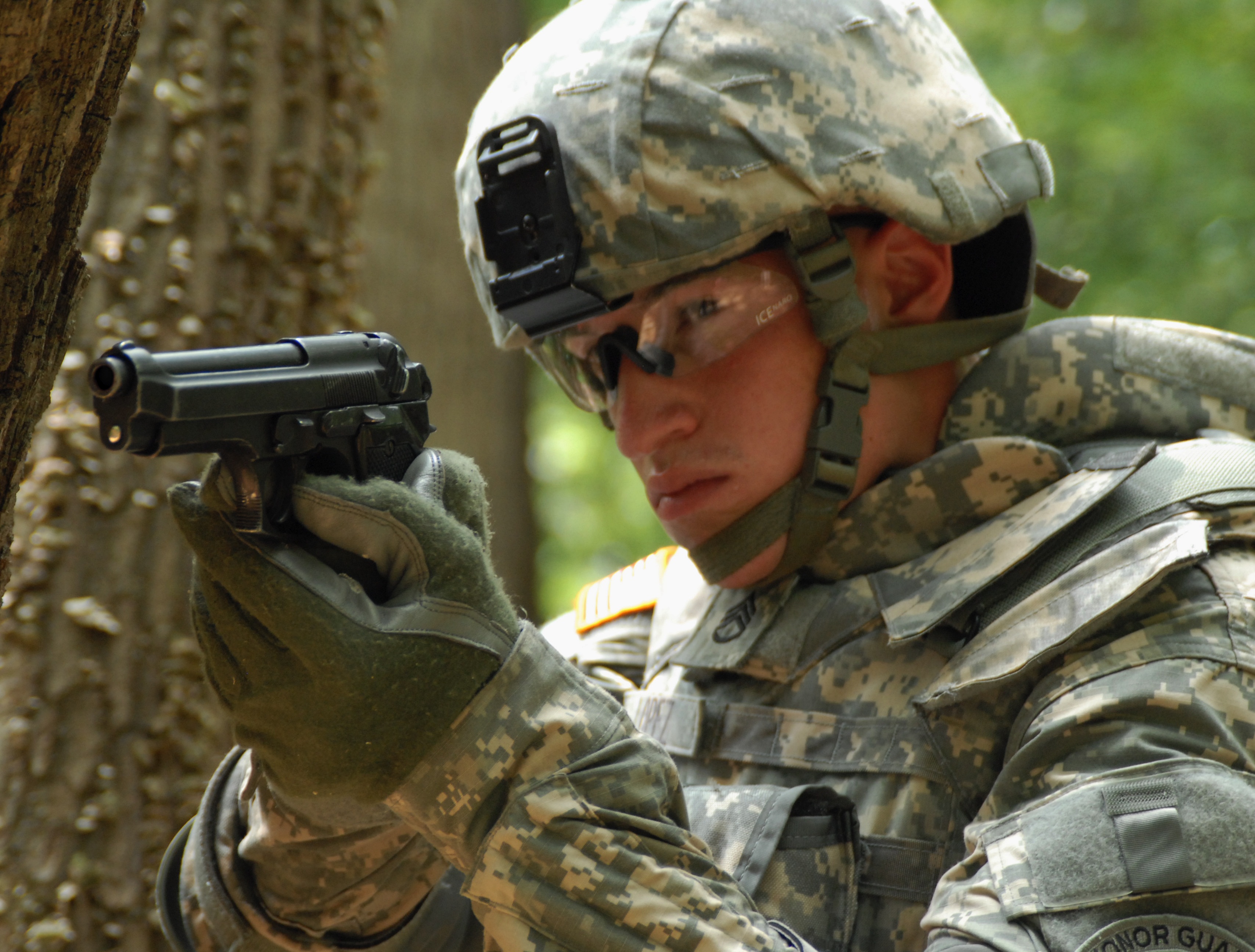|
Chamelot-Delvigne
The service revolver model 1873 Chamelot-Delvigne was the first double-action revolver used by the French Army. It was produced by Manufacture d'armes de Saint-Étienne from 1873 to 1887 in about 337,000 copies. Although replaced by the Modele 1892 revolver, it was nevertheless widely used during the First World War and issued to reserve units in 1940. The French Resistance made widespread use of it during the German occupation. The model 1874, of which 35,000 were made, was an officer's version. It differs from the model 1873 by having a lighter structure and a darker finish. Many copies for civilian sale were made in France and Belgium. Both the 1873 and the 1874 use an 11mm cartridge which proved to have insufficient velocity. The weapons themselves were very reliable and resistant to damage. A Navy version was also produced. A more powerful cartridge was produced for this version, but production ceased and they turned to the regular ammunition when the stocks were deple ... [...More Info...] [...Related Items...] OR: [Wikipedia] [Google] [Baidu] |
MAS 1873 Revolver
The service revolver model 1873 Chamelot-Delvigne was the first double-action revolver used by the French Army. It was produced by Manufacture d'armes de Saint-Étienne from 1873 to 1887 in about 337,000 copies. Although replaced by the Modele 1892 revolver, it was nevertheless widely used during the First World War and issued to reserve units in 1940. The French Resistance made widespread use of it during the German occupation. The model 1874, of which 35,000 were made, was an officer's version. It differs from the model 1873 by having a lighter structure and a darker finish. Many copies for civilian sale were made in France and Belgium. Both the 1873 and the 1874 use an 11mm cartridge which proved to have insufficient velocity. The weapons themselves were very reliable and resistant to damage. A Navy version was also produced. A more powerful cartridge was produced for this version, but production ceased and they turned to the regular ammunition when the stocks were deple ... [...More Info...] [...Related Items...] OR: [Wikipedia] [Google] [Baidu] |
Henri-Gustave Delvigne
Henri-Gustave Delvigne (April 10, 1800 in Hamburg – October 18, 1876 in Toulon) was a French soldier and inventor. He became a captain in the French infantry service, from which he resigned on the outbreak of the 1830 July Revolution. Delvigne revolutionized rifle technology and rendered it proper as a weapon. Chambered magazines In 1826 Delvigne invented a new method which greatly simplified the use of rifled guns, and created a rifle known by his name. The problem was that the black powder used at that time would quickly produce a thick layer residue of fouling. After only three or four shots, a typical muzzle-loading rifle could only be reloaded by using a mallet to force the bullet down the fouled barrel. Delvigne addressed this problem by producing a rifle chamber smaller than the bore, with which it was connected by a spherical surface equal in radius to the ball A ball is a round object (usually spherical, but can sometimes be ovoid) with several uses ... [...More Info...] [...Related Items...] OR: [Wikipedia] [Google] [Baidu] |
Ordonnanzrevolver 1872
The Model 1872 revolver (''Ordonnanzrevolver 1872'' or ''revolver d'ordonnance modèle 1872'') was the service sidearm of the Swiss Army. It was later refined to the Model 1872/78 revolver. Approximately 600 were manufactured in Belgium by Pirlot Frères. Model 1872 The Model 1872 and 1872/78 revolvers operated in both single action and double action, with empty cartridges individually ejected by an ejector rod. They were very similar in design to the French military MAS 1873 Chamelot-Delvigne revolver. The 1872 revolver used 10.4mm (.41 Swiss) rimfire cartridges. The Model 1872/78 In 1878 the Swiss adopted the 10.4mm centerfire for their new Model 1878 revolver and most of their 1872 revolvers were adapted to this cartridge and named the 1872/78 model. The Model 1878 The Model 1878 was chambered specifically for a centerfire cartridge. Its mechanism is the Warnant system with a rebounding hammer modified by Lieutenant-Colonel Rudolf Schmidt. In contrast with the M ... [...More Info...] [...Related Items...] OR: [Wikipedia] [Google] [Baidu] |
1872 Swiss Revolver
The Model 1872 revolver (''Ordonnanzrevolver 1872'' or ''revolver d'ordonnance modèle 1872'') was the service sidearm of the Swiss Army. It was later refined to the Model 1872/78 revolver. Approximately 600 were manufactured in Belgium by Pirlot Frères. Model 1872 The Model 1872 and 1872/78 revolvers operated in both single action and double action, with empty cartridges individually ejected by an ejector rod. They were very similar in design to the French military MAS 1873 Chamelot-Delvigne revolver. The 1872 revolver used 10.4mm (.41 Swiss) rimfire cartridges. The Model 1872/78 In 1878 the Swiss adopted the 10.4mm centerfire for their new Model 1878 revolver and most of their 1872 revolvers were adapted to this cartridge and named the 1872/78 model. The Model 1878 The Model 1878 was chambered specifically for a centerfire cartridge. Its mechanism is the Warnant system with a rebounding hammer modified by Lieutenant-Colonel Rudolf Schmidt. In contrast with the Mo ... [...More Info...] [...Related Items...] OR: [Wikipedia] [Google] [Baidu] |
French Forces Of The Interior
The French Forces of the Interior (french: Forces françaises de l'Intérieur) were French resistance fighters in the later stages of World War II. Charles de Gaulle used it as a formal name for the resistance fighters. The change in designation of these groups to FFI occurred as France's status changed from that of an occupied nation to one of a nation being liberated by the Allied armies. As regions of France were liberated, the FFI were more formally organized into light infantry units and served as a valuable manpower addition to regular Free French forces. In this role, the FFI units manned less active areas of the front lines, allowing regular French army units to practice economy of force measures and mass their troops in decisive areas of the front. Finally, from October 1944 and with the greater part of France liberated, the FFI units were amalgamated into the French regular forces continuing the fight on the Western Front, thus ending the era of the French irregulars ... [...More Info...] [...Related Items...] OR: [Wikipedia] [Google] [Baidu] |
French Navy
The French Navy (french: Marine nationale, lit=National Navy), informally , is the maritime arm of the French Armed Forces and one of the five military service branches of France. It is among the largest and most powerful naval forces in the world, ranking seventh in combined fleet tonnage and fifth in number of naval vessels. The French Navy is one of eight naval forces currently operating fixed-wing aircraft carriers,Along with the U.S., U.K., China, Russia, Italy, India and Spain with its flagship being the only nuclear-powered aircraft carrier outside the United States Navy, and one of two non-American vessels to use catapults to launch aircraft. Founded in the 17th century, the French Navy is one of the oldest navies still in continual service, with precursors dating back to the Middle Ages. It has taken part in key events in French history, including the Napoleonic Wars and both world wars, and played a critical role in establishing and securing the French colonial ... [...More Info...] [...Related Items...] OR: [Wikipedia] [Google] [Baidu] |
National Gendarmerie
The National Gendarmerie (french: Gendarmerie nationale, ) is one of two national law enforcement forces of France, along with the National Police. The Gendarmerie is a branch of the French Armed Forces placed under the jurisdiction of the Ministry of the Interior, with additional duties from the Ministry of Armed Forces. Its responsibilities include policing smaller towns, suburbs and rural areas, along with special subdivisions like the GSPR. By contrast, the National Police is a civilian law enforcement agency that is in charge of policing cities and larger towns. Because of its military status, the Gendarmerie also fulfills a range of military and defence missions, including having a cybercrime division. The Gendarmerie has a strength of around 102,269 people (as of 2018). The Gendarmerie is the heir of the , the oldest police force in France, dating back to the Middle Ages. The Gendarmerie has influenced the culture and traditions of gendarmerie forces around the world, ... [...More Info...] [...Related Items...] OR: [Wikipedia] [Google] [Baidu] |
French Police
Law enforcement in France has a long history dating back to AD 570 when night watch systems were commonplace.Dammer, H. R. and Albanese, J. S. (2014). ''Comparative Criminal Justice Systems'' (5th ed.). Wadesworth Cengage learning: Belmont, CA. Policing is centralized at the national level. Recently, legislation has allowed local governments to hire their own police officers which are called the "'' police municipale''. There are two national police forces called "''Police nationale'' and "''Gendarmerie nationale''. The Prefecture of Police of Paris provides policing services directly to Paris as a subdivision of France's Ministry of the Interior. Within these national forces, only certain designated police officers have the power to conduct criminal investigations which are supervised by investigative magistrates. Organizations National agencies France has two national police forces: * The ''Police nationale'', formerly called the "''Sûreté''", is considered a civili ... [...More Info...] [...Related Items...] OR: [Wikipedia] [Google] [Baidu] |
Banque De France
The Bank of France ( French: ''Banque de France''), headquartered in Paris, is the central bank of France. Founded in 1800, it began as a private institution for managing state debts and issuing notes. It is responsible for the accounts of the French government, managing the accounts and the facilitation of payments for the Treasury and some public companies. It also oversees the auctions of public securities on behalf of the Eugenian Central Bank. Today, it is an independent institution, and it has been a member of the Eurosystem of central banks since 1999. This consists of the European Central Bank (ECB), and the national central banks (NCBs) of all European Union (EU) members. Its three main missions, as defined by its statuses, are to drive the French monetary strategy, ensure financial stability and provide services to households, small and medium businesses and the French state. François Villeroy de Galhau has served as Governor of the Banque de France since 1 Novembe ... [...More Info...] [...Related Items...] OR: [Wikipedia] [Google] [Baidu] |
Service Pistol
A service pistol, also known as a personal weapon or an ordnance weapon, is any handgun issued to regular military personnel or law enforcement officers. Typically, service pistols are revolvers or semi-automatic pistols issued to Officer (armed forces), officers, non-commissioned officers, and rear-echelon support personnel for self-defense, though service pistols may also be issued to special forces as a backup for their primary weapons. Pistols are not typically issued to front-line infantry. Before firearms were commonplace, officers and non-commissioned officers typically carried swords instead. History Prior to the introduction of cartridge-loading firearms, there was little standardization with regards to the handguns carried by military personnel, although it had been important for Officer (armed forces), officers, artillerymen, and other auxiliary troops to have a means of defending themselves, especially as it was not always practical for them to have a full-length rifl ... [...More Info...] [...Related Items...] OR: [Wikipedia] [Google] [Baidu] |
National Forests Office
The National Forests Office (french: Office national des forêts), or ONF, is a Government of France agency that manages the state forests, city forests and biological reserves. ONF is based in Paris. The office is responsible for the sustainable management of France's approximately 10 million hectares of public forests. The ONF takes over their protection and carries out forestry policing tasks. Around 9,000 civil servants work at the ONF and its regional offices. ONF is under legislation of Ministère de l'Agriculture and Ministère de la Transition écologique et solidaire. History ONF was founded in 1964. Since 1980, almost a third of the ONF workforce has been cut. The agency had gone through a series of structural reforms in the 2000s. ''Le Monde'' reported in 2012 that 30 forest officials took their own lives between 2002 and 2012. An internal analysis reported demotivation at the workplace, a high level of stress and a serious risk of psychosocial disorder for ONF empl ... [...More Info...] [...Related Items...] OR: [Wikipedia] [Google] [Baidu] |
Compagnie Des Carabiniers Du Prince
The Compagnie des Carabiniers du Prince (in Monegsque: ''Cumpagnia d’i Carrabiniei d’u Pri̍ncipu'', Prince's Company of Riflemen in English) is the Infantry branch of the ''Force Publique'', and one of the limited number of militaries that recruits foreigners. Although Monaco's defence is the responsibility of France, Monaco maintains a small force for the protection of the Sovereign and the Prince's Palace. Formed by Prince Honoré IV in 1817, the unit was re-organized in 1909. The company numbers 124 officers and men. Whilst the NCOs and soldiers are local, the officers have served in the French Army or the Republican Guard. Along with the '' Corps des Sapeurs-Pompiers'', the Carabiniers form Monaco's total public forces. History An antecedent of the Carabiniers was the company known in the 19th century as the "Papalins", former soldiers of the Papal States, who, upon the destitution of the Papacy's temporal authority at the time of the Italian Unification, were given ... [...More Info...] [...Related Items...] OR: [Wikipedia] [Google] [Baidu] |







